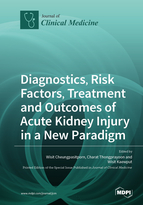Diagnostics, Risk Factors, Treatment and Outcomes of Acute Kidney Injury in a New Paradigm
A special issue of Journal of Clinical Medicine (ISSN 2077-0383). This special issue belongs to the section "Nephrology & Urology".
Deadline for manuscript submissions: closed (31 December 2019) | Viewed by 178687
Special Issue Editors
Interests: artificial Intelligence; machine learning; meta-analysis; acute kidney injury; clinical nephrology; kidney transplantation
Special Issues, Collections and Topics in MDPI journals
Interests: artificial intelligence; machine Learning; nephrology; acute kidney injury; clinical nephrology; kidney transplantation
Special Issues, Collections and Topics in MDPI journals
Interests: machine learning; kidney transplantation; observational studies; statistical analysis; epidemiology
Special Issues, Collections and Topics in MDPI journals
Special Issue Information
Dear Colleagues,
Acute kidney injury (AKI) is a frequent clinical syndrome among hospitalized patients, independently associated with both short- and long-term mortality. Previous investigations have attempted to identify effective interventions to prevent AKI or promote kidney function recovery in patients with AKI. Nevertheless, most were unsuccessful. Hence, additional studies are required in the field of AKI research.
In this Special Issue, we are making a call to action to stimulate researchers and clinicians to submit their invaluable studies on AKI, as has been done in nephrology, internal medicine, critical care, and other disciplines that will provide additional knowledge and skills in the field of AKI research, ultimately to improve patient outcomes. Original investigations, review articles, and short communications are especially welcome.
Potential topics include, but are not limited to, the following:
AKI definition and diagnosis
AKI prevention
AKI in cardiac surgery
AKI after bone marrow or solid organ transplantation
Biomarkers of AKI
Cardiorenal Syndrome
Contrast-induced AKI
Critical care nephrology
Drug-induced AKI
Electronic AKI Alerts
Hepatorenal Syndrome
Ischemic reperfusion injury
Outcomes and complications associated with AKI
Pathogenesis of AKI
Postoperative AKI
Quality improvement projects in AKI care
Renal replacement therapy in ICU
Rhabdomyolysis-associated AKI
Risk factors/predictors for AKI
Remote ischemic preconditioning and renoprotection
Sepsis and AKI
Dr. Wisit Cheungpasitporn
Dr. Charat Thongprayoon
Dr. Wisit Kaewput
Guest Editors
Manuscript Submission Information
Manuscripts should be submitted online at www.mdpi.com by registering and logging in to this website. Once you are registered, click here to go to the submission form. Manuscripts can be submitted until the deadline. All submissions that pass pre-check are peer-reviewed. Accepted papers will be published continuously in the journal (as soon as accepted) and will be listed together on the special issue website. Research articles, review articles as well as short communications are invited. For planned papers, a title and short abstract (about 100 words) can be sent to the Editorial Office for announcement on this website.
Submitted manuscripts should not have been published previously, nor be under consideration for publication elsewhere (except conference proceedings papers). All manuscripts are thoroughly refereed through a single-blind peer-review process. A guide for authors and other relevant information for submission of manuscripts is available on the Instructions for Authors page. Journal of Clinical Medicine is an international peer-reviewed open access semimonthly journal published by MDPI.
Please visit the Instructions for Authors page before submitting a manuscript. The Article Processing Charge (APC) for publication in this open access journal is 2600 CHF (Swiss Francs). Submitted papers should be well formatted and use good English. Authors may use MDPI's English editing service prior to publication or during author revisions.
Keywords
- acute kidney injury
- acute renal failure
- biomarkers
- critical care
- renal replacement therapy
- risk factors
- outcomes
- predictors









